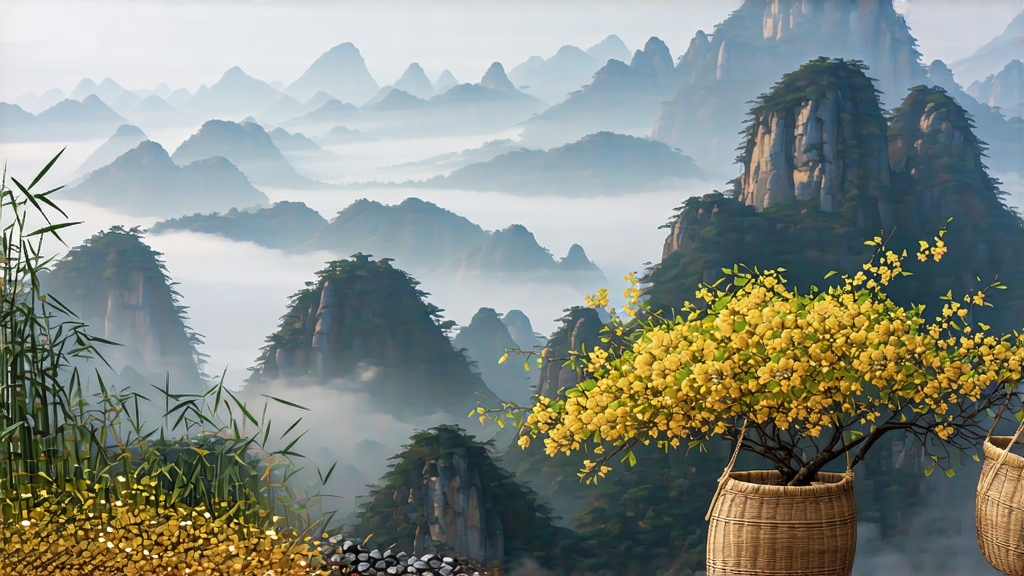
Tucked high in the mist-veiled Dabie Mountains of western Anhui Province, Huoshan Huangya has quietly captivated Chinese emperors, poets, and tea sages for more than seven centuries. Internationally it remains the least-known member of China’s six great tea families, yet within the yellow-tea category it is regarded as the benchmark against which all other “yellowed” teas are judged. To understand Huoshan Huangya is to witness a living relic of Song-dynasty craftsmanship, a tea whose very colour evokes the golden robes of the Son of Heaven and whose flavour suspends time between green freshness and red maturity.
Historical scrolls first record the tea in 1306, when the imperial censor brought a small bamboo caddy of “Huoshan sprouts” to the Yuan court. By the Ming dynasty the buds had become tribute, carried 1,200 km north along the post-roads that linked the tea-producing county of Huoshan to Beijing’s Forbidden City. Legend claims that the Wanli Emperor (r. 1572-1620) so prized the tea’s bright yellow liquor that he granted the mountain villagers a permanent exemption from the grain tax, provided they deliver the first fifty liang of spring buds to the palace each Qingming festival. The concession endured until 1908, when the last Qing caravan left Huoshan under armed escort. Thereafter the technique of “menhuang” (the slow yellowing that defines the category) almost vanished during the Republican era’s civil turmoil. It was resurrected in 1972 when a team of Anhui agronomists recovered the original eight-page manuscript “Huoshan Xiancha Zhi,” hidden inside a hollow tile in the ruined Longchuan Monastery. Today the county’s 6,800 hectares of certified gardens produce fewer than 180 tonnes of authentic Huangya each year, a figure that secures its status as one of China’s rarest commercially available teas.
The cultivar itself is a local variant of Camellia sinensis var. sinensis known colloquially as “Jinji Zhong,” Golden Rooster Cultivar. Its diminutive leaves, picked when still closed “fish-hook” buds no longer than 25 mm, contain up to 5.8 % L-theanine and a unique ratio of chlorophyll a/b that favours the mellowing reactions crucial to menhuang. Gardens lie between 600 m and 900 m on granite soils weathered by monsoon mists; the average cloud cover exceeds 220 days annually, slowing photosynthesis and concentrating amino acids. Night temperatures drop 8 °C below daytime highs, prompting the bushes to store citral and geraniol in their leaf wax—aromatic precursors that later translate into Huoshan Huangya’s signature orchid-chestnut bouquet.
Plucking begins at dawn on the first day after the spring “waking of insects” (early March), when two-thirds of the mountain is still locked in hoarfrost. Only the standard “one bud with one unfolded leaf” is taken, a ritual repeated for barely ten mornings before Qingming. A seasoned picker can gather just 600 g of fresh leaf in a day, the equivalent of 120 g of finished tea. Baskets are woven fresh from bamboo that grew on north-facing slopes; the cooler fibres slow enzymatic browning during the 3 km descent to the village workshop.
Inside the stone-walled factory the craft unfolds across five meticulous stages, each calibrated to the mountain’s microclimate rather than the clock. First comes “shaqing” (kill-green) over a bamboo-roofed charcoal vat fired by local chestnut wood. The leaf is tossed by hand for 90–120 seconds at 160 °C until the sound of “popcorn in a rice field” is heard—an acoustic cue that the epidermis has set yet internal moisture remains above 62 %. Immediately the hot leaf is wrapped in thick canvas and placed inside a pine box lined with steamed rice straw. Here the critical menhuang phase begins: over 48–72 hours the bundle is opened every six hours to release trapped CO₂, then re-wrapped tighter each time. Oxidative enzymes oxidise catechins into theaflavins, while chlorophyll degrades into pheophytin, gifting the leaf its antique gold hue. The process is halted when the bud tips turn “imperial yellow” (Pantone 7406 C) and emit the scent of fresh corn silk. A low-temperature bake at 55